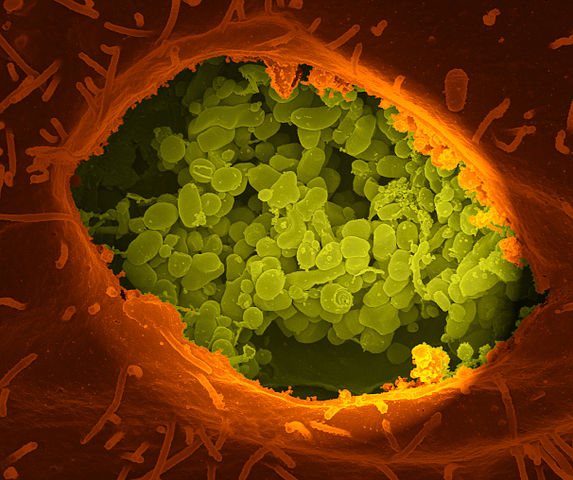Coxiella burnetii
| Coxiella burnetii | ||||||||||||||
|---|---|---|---|---|---|---|---|---|---|---|---|---|---|---|
 A dry fracture of a Vero cell exposing the contents of a vacuole where Coxiella burnetii are busy growing.
| ||||||||||||||
| Scientific classification | ||||||||||||||
| ||||||||||||||
| Binomial name | ||||||||||||||
| Coxiella burnetii (Derrick 1939) Philip 1948 |
Editor-In-Chief: C. Michael Gibson, M.S., M.D. [1]
Overview
Coxiella burnetii is an obligate intracellular bacterial pathogen, and is the causative agent of Q fever. The genus Coxiella is morphologically similar to Rickettsia, but with a variety of genetic and physiological differences. C. burnetii is a small Gram-negative bacterium that is highly resistant to environmental stresses such as high temperature, osmotic pressure, and ultraviolet light. These characteristics are attributed to a small cell variant form of the organism that is part of a biphasic developmental cycle, including a more metabolically and replicatively active large cell variant form.[1] It can survive standard disinfectants, and is resistant to many other environmental changes like those presented in the phagolysosome.[2]
Pathogenesis

The ID50 (the dose needed to infect 50% of experimental subjects) is one via inhalation; i.e., inhalation of one organism will yield disease in 50% of the population. This is an extremely low infectious dose (only 1-10 organisms required), making C. burnetii one of the most infectious known organisms.[3][4] Disease occurs in two stages: an acute stage that presents with headaches, chills, and respiratory symptoms, and an insidious chronic stage.
While most infections clear up spontaneously, treatment with tetracycline or doxycycline appears to reduce the symptomatic duration and reduce the likelihood of chronic infection. A combination of erythromycin and rifampin is highly effective in curing the disease, and vaccination with Q-VAX vaccine (CSL) is effective for prevention of it. [Source?]
The bacteria use a Type IVB secretion system known as Icm/Dot to inject effector proteins called Ank proteins into the host. These effectors increase the bacteria's ability to survive inside the host cell. In Legionella pneumophila, which uses the same secretion system and also injects Ank proteins, survival is enhanced because these Ank proteins interfere with fusion of the bacteria-containing vacuole with the host's degradation endosomes.[5]
Genomics
There are currently at least 5 completely sequenced genomes of Coxiella burnetti [6] which contain about 2.1 Mbp of DNA each and encode around 2,100 open reading frames. 746 (or about 35%) of these genes have no known function.
References
- ↑ Voth, D. E. & Heinzen (2007), "Lounging in a lysosome: The intracellular lifestyle of Coxiella burnetii", Cellular Microbiology, 9 (4): 1829–840, doi:10.1111/j.1462-5822.2007.00901.x, PMID 17381428
- ↑ Sankaran, Neeraja (2000). "Coxiella burnetii". Microbes and people : an A-Z of microorganisms in our lives. Phoenix, Arizona: The Oryx Press. p. 72. ISBN 1-57356-217-3. "In contrast to other rickettsiae, which are highly sensitive and easily killed by chemical disinfectants and changes in their surroundings, C. burnetii is highly resistant" & "Q fever". Centers for Disease Control and Prevention; National Center for Infectious Diseases; Division of Viral and Rickettsial Diseases; Viral and Rickettsial Zoonoses Branch. 2003-02-13. Retrieved 2006-05-24. "The organisms are resistant to heat, drying, and many common disinfectants."
- ↑ "Airborne Q fever". 25. September 1961: 285–93. PMC 441106. PMID 13921201.
- ↑ Q fever caused by Coxiella burnetii
- ↑ Pan, X.; Lührmann, A.; Satoh, A.; Laskowski-Arce, M. A. & Roy, C. R. (2008), "Ankyrin repeat proteins comprise a diverse family of bacterial type IV effectors", Science, 320 (5883): 1651–1654, doi:10.1126/science.1158160, PMC 2514061, PMID 18566289
- ↑ "Coxiella genomes in the PATRIC database". Retrieved 1 October 2012.
External links
- Coxiella burnetii genomes and related information at PATRIC, a Bioinformatics Resource Center funded by NIAID